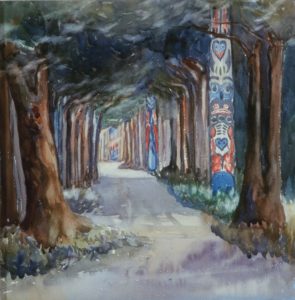Canadian artist and Victoria resident Emily Carr may have painted her scenes close to 100 years ago, but her work has never been more relevant than it is today, says Art Gallery of Greater Victoria acting chief curator Nicole Stanbridge. Stanbridge is also co-curator of a new exhibit, Emily Carr: Seeing and Being Seen, at the gallery. The exhibit displays Carr’s work as well as work inspired by Carr.
Stanbridge says it’s important to use the work in the exhibit to talk about current issues, because Carr was painting scenes from Indigenous land and culture.
“The environment, the current climate around coming to terms with the history of residential schools and that, kind of, belief, is so overwhelming right now,” says Stanbridge.

Carr is celebrated for documenting and painting Indigenous villages; the exhibit features one painting by Joane Cardinal-Schubert—an Indigenous artist born in Red Deer, Alberta who died in 2009—that is a visual representation of a conversation with Carr.
“[Cardlinal-Schubert was] relating to her as a woman artist and the struggles that she could relate to, but also, challenging Carr… Through that work, she’s also kind of critiquing Carr,” says Stanbridge. “That was a really interesting piece that was an entry point to us talking about using Carr’s work as a way to talk about more current issues.”
The work by other artists in the exhibit expands on notions of a changing landscape in Victoria, both literally and metaphorically, which can also be seen in Carr’s 1939 piece “Odds and Ends.”
“[The piece] is a record of the gravel-pit site in Colwood, which is now becoming a booming residential development,” says Stanbridge. “To see that landscape shift—she was already seeing the impacts of that to local communities and to Indigenous communities—with how much industrial logging and all those things were impacting the landscape, that brings us all the way to today, to Fairy Creek and the logging issues that are happening right now.”
The timelessness of Carr’s work is one of the main reasons people are drawn to it today. A few other works, such as “Totem Walk at Sitka,” painted in 1907, allows viewers to talk about perspective, appropriation, and why appropriation is harmful, says Stanbridge.
“Carr was really celebrated for documenting these village sites at the same time that there was a potlach ban and people were being arrested and persecuted and oppressed for celebrating that same culture,” she says. “That’s the essence of the damage of appropriation. Folks not from that culture who take it on become celebrated for it, while the folks whose culture it is from, when they express that, it’s something that they’re persecuted for. [The exhibit] gives us an opportunity to talk about that layer of things.”
Emily Carr: Seeing and Being Seen
Until Sunday, July 17, 2022
Art Gallery of Greater Victoria
aggv.com
